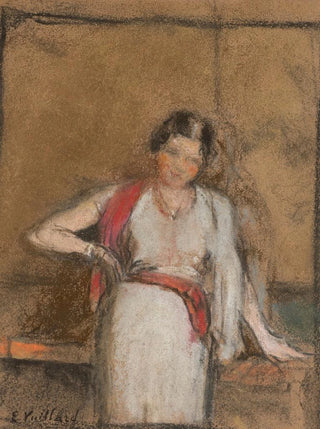Art print | Study for the portrait of Madame Freyssinet - Édouard Vuillard


View from behind

Frame (optional)
The artwork "Study for the portrait of Madame Freyssinet" by Édouard Vuillard is an iconic piece that embodies the delicacy and intimacy of the artist's inner world. This study, created at the end of the 19th century, reflects an era when painting was freeing itself from academic constraints to explore more personal and emotional subjects. Vuillard, a member of the Nabi movement, is interested in depicting everyday life, and this portrait is no exception. The way he captures the essence of his model, Madame Freyssinet, evokes a psychological depth that invites viewers to reflect on the relationship between the artist and his subject. This work, both intimate and universal, unfolds like a mirror of human feelings, a reflection of passing time.
Style and uniqueness of the work
In "Study for the portrait of Madame Freyssinet," Vuillard employs a characteristic style that combines an impressionist touch with decorative sensitivity. The soft colors and delicate textures create a warm and welcoming atmosphere. The artist uses a palette of pastel tones that envelops the subject in an aura of serenity. Floral motifs and environmental elements, often present in his works, blend harmoniously with the figure of Madame Freyssinet, creating a composition where the subject and the decor seem in symbiosis. This approach to color and form demonstrates a constant search for visual harmony, while maintaining a certain spontaneity. The way Vuillard plays with light and shadow accentuates his model's features, giving her an almost tactile presence. Each brushstroke appears charged with emotion, making this study not only a portrait but also an exploration of the human soul.
The artist and his influence
Édouard Vuillard, born in Cuiseaux in 1868, is one of the major figures of the Nabi movement, which advocates a more symbolic and personal approach to painting. Influenced by the ideas of Paul Gauguin and the pursuits of the Impressionists, Vuillard develops a unique style that blends everyday life with an almost dreamlike dimension.

Matte finish

View from behind

Frame (optional)
The artwork "Study for the portrait of Madame Freyssinet" by Édouard Vuillard is an iconic piece that embodies the delicacy and intimacy of the artist's inner world. This study, created at the end of the 19th century, reflects an era when painting was freeing itself from academic constraints to explore more personal and emotional subjects. Vuillard, a member of the Nabi movement, is interested in depicting everyday life, and this portrait is no exception. The way he captures the essence of his model, Madame Freyssinet, evokes a psychological depth that invites viewers to reflect on the relationship between the artist and his subject. This work, both intimate and universal, unfolds like a mirror of human feelings, a reflection of passing time.
Style and uniqueness of the work
In "Study for the portrait of Madame Freyssinet," Vuillard employs a characteristic style that combines an impressionist touch with decorative sensitivity. The soft colors and delicate textures create a warm and welcoming atmosphere. The artist uses a palette of pastel tones that envelops the subject in an aura of serenity. Floral motifs and environmental elements, often present in his works, blend harmoniously with the figure of Madame Freyssinet, creating a composition where the subject and the decor seem in symbiosis. This approach to color and form demonstrates a constant search for visual harmony, while maintaining a certain spontaneity. The way Vuillard plays with light and shadow accentuates his model's features, giving her an almost tactile presence. Each brushstroke appears charged with emotion, making this study not only a portrait but also an exploration of the human soul.
The artist and his influence
Édouard Vuillard, born in Cuiseaux in 1868, is one of the major figures of the Nabi movement, which advocates a more symbolic and personal approach to painting. Influenced by the ideas of Paul Gauguin and the pursuits of the Impressionists, Vuillard develops a unique style that blends everyday life with an almost dreamlike dimension.






